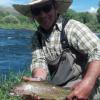-
Content Count
85 -
Joined
-
Last visited
-
Wow. This thread is a little self-righteous and probably hypocritical. if I choose to have a beer or three, as long as I am not breaking the law, it is not your concern. if I am breaking the law, it's still none of your business until it affects you directly. Yes, I know some people can't handle it or don't know when to stop. That's some, not all. You're convicting people before they commit a crime. if you don't want to have a beer while you're fishing then don't. If you don't want to fish with me if I crack a cold one, then don't. We'll probably both be better off. There would be a whole lot less fuss and bother in this world if people just minded their own damn business. And for the record, no story worth telling ever started with milk.
-
Thanks, @Poopdeck. Seems like this might be a cheap enough experiment.
-
Following this conversation and I have a question: Does the ring cause hinging in the leader? It seems like it would break to transmission of energy down the leader. I don't use rings as my tippet sections are more robust and I've always just tied new sections and leaders as needed but I can see the need when you have small diameter tippets. It might be something to look into since I use a fluorocarbon tippet section almost exclusively.
-

How do you know when a dubbing brush is done?
FliesbyNight replied to FliesbyNight's topic in Fly Fishing Gear & Techniques
Thanks, TroutTramp. I'll check that out. Thanks Poopdeck. That's about the dimensions of my table as well. I do have a variable speed motor with a foot pedal. I was thinking of doing the hand crank version but I had this motor sitting on the shelf, see, and well...... I can't help thinkering. -
Ok, so I am almost finished making a dubbing brush machine. The trial run works fine but I just used string to make sure the static side pulled in with tension about 1 1/2" My question is: How do I know when I have enough twists? Run it until the wire breaks? Just figure it out with use? The rotary force is an old sewing machine motor I had in the shop so counting is not really an option.
-
@flytire, what application is that screen shot from? And what is the library like? I'm intrigued.....
-

What is your favorite fly fishing Rod?
FliesbyNight replied to Stuart Fluke's topic in Fly Fishing Gear & Techniques
Agreed, @Poopdeck. I never paid more than $240 for a rod but I have had a few I was less than satisfied with. I always shop the outlets for discontinued models. That's why I have a lot of Orvis stuff, there's an outlet in Rehoboth Beach Delaware where my wife and I spend long weekends. I'm much more loyal to the dead presidents in my wallet and it always amuses me that what was the hottest rod ever 3 years ago I just bought for less than 35% of the original price. -

What is your favorite fly fishing Rod?
FliesbyNight replied to Stuart Fluke's topic in Fly Fishing Gear & Techniques
-
Thanks, @Jaydub. Looks like it. I may have to google those and see if I can figure an application for tying I'm salt only so maybe...
-
Someone already PM'd me so they are alloted.
-
So a friend of mine who recently passed away was getting into fly tying and I am slowly inheriting his stuff as his wife goes through it. I came across some pieces in his kit that I cannot identify. I assume he intended to use them for tying because they were in the kit with beads and hooks but I have no idea what the flying hell they might be used for. You might not be able to see it but there is a small hole in the tip. Any ideas?
-
I have always enjoyed looking at the great patterns in this section and may be able to give a little back. A friend of mine was getting into fly tying as a hobby and was trying new things to amuse himself. He passed recently and I have been inheriting his fishing stuff as his wife has the heart to go through it. Dunno what he was planning but i came across some salmon hooks he had and I have no use for them. The manufacturer is Harrison Bartleet. There are 6 7/0 blind hooks and 2 dozen or so (didn't count them) wet salmon down eyes in 2/0. If anyone is interesting, please PM me and I'll get them in the mail to you.
-
@SilverCreek, Based on your recommendation, I was contemplating trying a Norvise bobbin. At ~$95 a pop, I'll stick with $5 spring arm bobbins. This kinda ties in with the "Is fly tying worth it?" thread. It can save you money depending on your outlook and needs. I'll manually roll up my excess thread and spend that money elsewhere, like say on materials or fly line. To each their own, which is part of the beauty of this hobby.
-
As with everything else in this ridiculous hobby, it all depends on your goals and practices and what you want out of it. I agree with @mikechell. If you tie what you need, stay away from the exotics and do it over a long time, you will save money. If you are into classic salmon flies that call for select plumage from a red-necked fuzzwort harvested under the light of a full moon, probably not. Even adding in the expense of all the tools and kit, I have saved money over the course of my tying and fishing. I tie about 24 different patterns, unless I'm going on a trip. I tie to imitate the bait fish local to my home waters. I tie each pattern in two sizes and maybe three color variations at most. That cuts down on the materials I need on hand. I'm strictly saltwater because of where I live and what I like to do so that simplifies my problem. When you consider that the flies I fish with cost between $4.00 and $15.00 each if bought commercially, but costs me around $2.00 each to tie at most, it doesn't take too long to start realizing some savings. I'm also a DIY type. I bought a good roll-top desk for a song and modified it to suit my needs. I made my own dubbing brush machine and twist my own brushes. When you add in the hours of enjoyment I get out of tying, it's a clear win-win.
-
@Silver Creek, I'm not sure how you made that leap but it is incorrect. I've tied on a rotary vise for over twenty years and actually use the functionality for palmering and sculpting epoxy. I find the spring arm bobbins simpler and easier to use. Any bobbin with a mechanical tensioner has to be adjusted for different tensions even if you can squeeze the spool. The Norvise bobbin you mention must have a spring to control the length of the thread that requires periodic adjusting. Any mechanical device will eventually fail. It may take a long time but it will happen and no manufacturing process is perfect. The more mechanically complicated a device, the greater the probability of failure. I still own and use the first bobbin I ever bought well over two decades ago. I only own three bobbins, all spring arms with long throats and ceramic inserts. The only reason own three is because I often use more than one thread color or type in the same fly. I've tried a few other types and given them all away.



